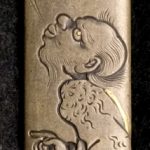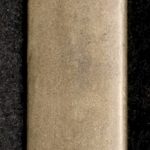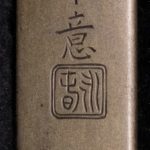JOI / SENNIN
KOZUKA NARA JOI (KAO)
TEKKAI SENNIN
MEI: JOI + KAO
DATE: NONE c. 1701-1761
From Joly’s Legend in Japanese Art”.
Tekkai Chinese Sennin, Li T’ieh Kwai Sien Sheng, one of the eight chief immortals of Taoist lore. He is depicted as a man of beggarly appearance and repulsive face, blowing his spirit into space in the form of a miniature figure, which is seen on the reverse side of the kozuka. The entire story can be found in Joly’s page 527. (Thanks to Irina Solo for pointing out the depiction).
Sugiura Joi was one of the Nara Sansaku or three great masters along with Tsuchiya Yasuchika and Nara Toshinaga. Joi was his Nyudo go after he entered the priesthood, prior to that he signed Nagaharu.
While doing research on this kozuka, I found there to be discrepancies even between the ones in the reference materials, especially with the Kao. Every one of them looked different. ???
Courtesy of Sesko’s:
Sugiura Jōi (杉浦乗意)
Sugiura Jōi – first name was „Tashichi“ (太七) and later „Sen´emon“ (仙右衛門) – was born in the 14th year of Genroku (1701) as the son of a retainer of the Toda-Matsudaira family (戸田松平) in their lands (i.e. the Kanō fief, 加納藩) in Mino province. The Toda – or at least some branches of them – were transferred several times during the early years of the Kyōhō era (1716-1736) and that is how Jōi came to Edo to work at the Toda-Matsudaira depot in the Fukugawa district (深川). As a Matsudaira branch and therefore related to the Tokugawa family, the Toda took an active part in the bakufu government. The transmission says that he studied under Nara Toshinaga (寿永) and on the recommendation of Toshinaga (利永), the 4th gen. Nara mainline, he was allowed to use the character „naga“ (永) and the family name „Nara“. Upon this he took the name „Nagaharu“ (永春) and „Jōi“ was his nyūdō-gō after entering priesthood. He also used the pseudonyms „Issan“ (一蝅) and „Issandō“ (一蝅堂), whereas he also signed the „san“ (蝅) character in the uncommon variant (蠺).
He sometimes also signed the name „Nara“ with the characters (南良).
Sugiura Jōi made many fuchigashira and kozuka, tsuba are rather rare. He worked mainly in polished shibuchi and never in shakudō with nanako ground. His strong points were the techniques of shishiaibori (肉合彫) and sukisagebori (鋤下彫), that means a bas-relief where the ground plate and the highest points of the motif are about level. This interpretation was later adopted by the Hamano school and the Mito-kinkō. Sugiura Jōi died on the 24th day of the seventh month of Hōreki eleven (1761) at the age of 61.
*Sadly, there are no papers for this kozuka. As with any un-papered item, all information regarding the mei is a simple translation of what is inscribed on the item. This and any other information given such a school history, etc., is done so as a courtesy only and is not an opinion, indication, or guarantee of it being shoshin or anything for that matter. (see policy page). If you wish to assume anything, assume it is gimei. No guarantee or warranty shall be given or implied. All un-papered items are sold “as is” and sales are final.
Items which are not accompanied by kanteisho (papers) are assumed gimei and valued based upon the quality of work seen in said item. If you are more concerned with papers or mei than the work, then please do your own research prior to purchase. Do your research PRIOR to purchase and make a purchase only if you are satisfied that you can live with your decision as again these sales are final.
All I can say with certainty is that this is a beautiful kozuka. Although there are no papers with this work, the quality of the work and the quality of the mei lead me to believe the probability of this work being shoshin is very high.
$1200 plus S/H and any associated fees (PayPal, bank wire, etc.)TEKKAI



